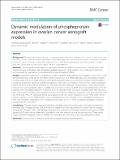Dynamic modulation of phosphoprotein expression in ovarian cancer xenograft models
Abstract
Background: The dynamic changes that occur in protein expression after treatment of a cancer in vivo are poorly described. In this study we measure the effect of chemotherapy over time on the expression of a panel of proteins in ovarian cancer xenograft models. The objective was to identify phosphoprotein and other protein changes indicative of pathway activation that might link with drug response. Methods: Two xenograft models, platinum-responsive OV1002 and platinum-unresponsive HOX424, were used. Treatments were carboplatin and carboplatin-paclitaxel. Expression of 49 proteins over 14 days post treatment was measured by quantitative immunofluorescence and analysed by AQUA . Results: Carboplatin treatment in the platinum-sensitive OV1002 model triggered up-regulation of cell cycle, mTOR and DDR pathways, while at late time points WNT, invasion , EMT and MAPK pathways were modulated. Estrogen receptor-alpha (ESR1) and ERBB pathways were down-regulated early, within 24h from treatment administration. Combined carboplatin-paclitaxel treatment triggered a more extensive response in the OV1002 model modulating expression of 23 of 49 proteins. Therefore the cell cycle and DDR pathways showed similar or more pronounced changes than with carboplatin alone . In addition to expression of pS6 and pERK increasing, components of the AKT pathway were modulated with pAKT increasing while its regulator PTEN was down-regulated early. WNT signaling, EMT and invasion markers were modulated at later time points. Additional pathways were also observed with the NFκB and JAK/STAT pathways being up-regulated. ESR1 was down-regulated as was HER4, while further protein members of the ERB B pathway were upregulated late. By contrast, in the carboplatin-unresponsive HOX 424 xenograft, carboplatin only modulated expression of MLH1 while carboplatin-paclitaxel treatment modulated ESR1 and pMET.
Citation
Koussounadis , A , Langdon , S , Um , I H , Kay , C , Francis , K , Harrison , D J & Smith , V A 2016 , ' Dynamic modulation of phosphoprotein expression in ovarian cancer xenograft models ' , BMC Cancer , vol. 16 , 205 . https://doi.org/10.1186/s12885-016-2212-6
Publication
BMC Cancer
Status
Peer reviewed
ISSN
1471-2407Type
Journal article
Description
The authors thank Medical Research Scotland and the Scottish Funding Council. This work was su pported by Medical Research Scotland [FRG353 to V.A.S.]; the FP7 -‐ Directorate -‐ General for Research and Innovation of the European Commission [EU HEALTH -‐ F4 -‐ 2012 -‐ 305033 to Coordinating Action Systems Medicine -‐ D.J.H.]; the Chief Scientist Office of Scotland [D.J.H.], the Scottish Funding Council [D.J.H. and S.P.L.]. Health Canada Scholarship (Indspire) [KEF], Scottish Overseas Research Student Award Scheme (University of Edinburgh)[KEF] and the Three Fires Award (Wikwemikong Board of Education)[KEF].Collections
Items in the St Andrews Research Repository are protected by copyright, with all rights reserved, unless otherwise indicated.

